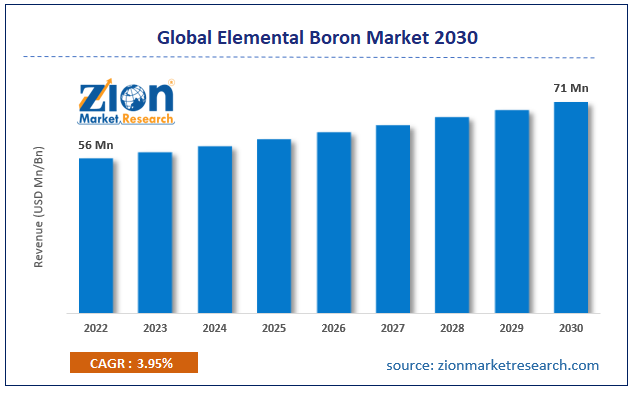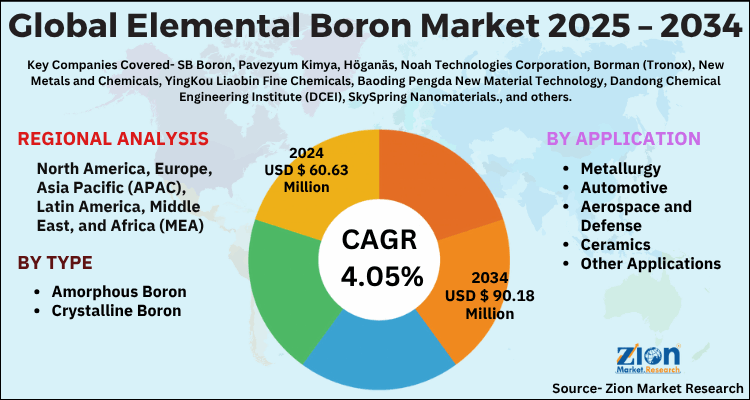Global Elemental Boron Market Size, Share, Growth Analysis Report - Forecast 2034

Elemental Boron Market By Type (Amorphous Boron, Crystalline Boron), By Application (Metallurgy, Automotive, Aerospace and Defense, Ceramics, Other Applications), and By Region: Global and Regional Industry Overview, Market Intelligence, Comprehensive Analysis, Historical Data, and Forecasts 2025 - 2034
| Market Size in 2024 | Market Forecast in 2034 | CAGR (in %) | Base Year |
|---|---|---|---|
| USD 60.63 Million | USD 90.18 Million | 4.05% | 2024 |
Elemental Boron Market: Industry Perspective
The global elemental boron market size was worth around USD 60.63 Million in 2024 and is predicted to grow to around USD 90.18 Million by 2034 with a compound annual growth rate (CAGR) of roughly 4.05% between 2025 and 2034. The report analyzes the global elemental boron market's drivers, restraints/challenges, and the effect they have on the demands during the projection period. In addition, the report explores emerging opportunities in the elemental boron industry.
Elemental Boron Market: Overview
Elemental boron is a non-metallic chemical element that is the lightest member of the boron group in the periodic table. Elemental boron is a dark, lustrous, brittle solid that is insoluble in water. It is a poor conductor of heat and electricity. Boron is found in small amounts in nature, but it is most commonly produced by the reduction of boron trichloride with hydrogen gas. It has various industrial applications and is a component in a range of products, from glass and ceramics to nuclear control systems. With the growing application in various sectors boron demand is expected to reach 5,500 kilotons by 2030.
Key Insights
- As per the analysis shared by our research analyst, the global elemental boron market is estimated to grow annually at a CAGR of around 4.05% over the forecast period (2025-2034).
- Regarding revenue, the global elemental boron market size was valued at around USD 60.63 Million in 2024 and is projected to reach USD 90.18 Million by 2034.
- The elemental boron market is projected to grow at a significant rate due to rising demand in nuclear shielding, growth in semiconductor and electronics industries, and increasing applications in high-energy fuels and advanced materials research.
- Based on Type, the Amorphous Boron segment is expected to lead the global market.
- On the basis of Application, the Metallurgy segment is growing at a high rate and will continue to dominate the global market.
- Based on region, Asia-Pacific is predicted to dominate the global market during the forecast period.
Elemental Boron Market: Dynamics
Key Growth Drivers:
Elemental boron demand is driven by its critical role in advanced materials and high-tech applications — including boron fibers and boron-doped semiconductors for aerospace, defense, and electronics — where its exceptional strength-to-weight ratio and electronic properties are prized. Growth is also supported by expanding markets for high-performance composites in automotive and aerospace for lightweighting, increasing R&D into boron-based anodes and catalysts for next-generation energy storage and hydrogen technologies, and steady industrial uses in metallurgy and specialty alloys that improve hardness and corrosion resistance.
Restraints:
The market faces restraints from the high cost and complexity of producing and purifying elemental boron to required specifications, which limits wider adoption versus cheaper boron compounds. Concentrated geographic supply of boron feedstocks and the capital-intensive nature of production create supply risk and price sensitivity. Regulatory and environmental constraints on mining and chemical processing, together with limited large-scale manufacturing infrastructure for advanced boron forms, further slow market expansion.
Opportunities:
Opportunities lie in commercialization of boron-enabled technologies — scalable boron fibers and nanoboron for ultra-light composites, boron-based anodes or additives for higher-performance batteries, and catalytic or sorbent roles in clean-energy systems. Emerging medical and niche industrial applications, value-added downstream processing (e.g., high-purity, shaped boron products), and expansion into emerging markets with growing aerospace and EV manufacturing present routes to higher margins and diversified demand. Strategic partnerships and investments in purification and processing capacity can unlock these opportunities.
Challenges:
Key challenges include volatile demand cycles tied to capital goods and aerospace/automotive spending, competition from lower-cost boron compounds that substitute for elemental boron in many uses, and technical hurdles in scaling advanced boron materials economically. Firms must also manage supply-chain concentration, ensure consistent high purity and form factor for specialized applications, and navigate environmental and safety regulations — all while investing in R&D to translate promising lab-scale boron innovations into commercially viable products.
Elemental Boron Market: Segmentation
The global Elemental Boron market is segmented based on type, application, and region. All the segments have been analyzed based on present and future trends and the market is estimated from 2025 to 2034.
Based on type, the global market segments are amorphous boron and crystalline boron. At present, the global elemental boron market is dominated by the amorphous boron segment. The properties of amorphous boron such as high melting point, hardness, and low density make it a choice of material for a variety of applications. Amorphous boron has a melting point of 2300°C and a hardness of 9.3 on the Mohs scale. This makes it a very strong and durable material. Also, amorphous boron has a density of 2.45 g/cm3. This makes it a lightweight material, which is important for applications where weight is a critical factor. Furthermore, Amorphous boron has a high thermal conductivity of 60 W/m·K. This makes it a good choice for applications where heat dissipation is important.
Based on application, the global elemental boron industry is categorized as metallurgy, automotive, aerospace and defense, ceramics, and other applications. Out of these, metallurgy was the largest shareholding segment in the global market. This is due to, elemental boron is widely used in metallurgy to improve the properties of metals, such as their strength, hardness, and corrosion resistance. It is used in the production of a variety of alloys, such as boron steel, boron carbide, and boron nitride. Boron steel is used in applications where high strength and toughness are required, such as in the automotive and aerospace industries. Boron carbide is used in applications where high hardness and wear resistance are required, such as in cutting tools and wear-resistant parts. Boron nitride is used in applications where high heat resistance and electrical insulation are required, such as in electronic components and thermal management applications.
The Regional, this segment includes the current and forecast demand for North America, Europe, Asia Pacific, Latin America,and the Middle East and Africa.
Elemental Boron Market: Report Scope
| Report Attributes | Report Details |
|---|---|
| Report Name | Elemental Boron Market |
| Market Size in 2024 | USD 60.63 Million |
| Market Forecast in 2034 | USD 90.18 Million |
| Growth Rate | CAGR of 4.05% |
| Number of Pages | 222 |
| Key Companies Covered | SB Boron, Pavezyum Kimya, Höganäs, Noah Technologies Corporation, Borman (Tronox), New Metals and Chemicals, YingKou Liaobin Fine Chemicals, Baoding Pengda New Material Technology, Dandong Chemical Engineering Institute (DCEI), SkySpring Nanomaterials., and others. |
| Segments Covered | By Type, By Application, and By Region |
| Regions Covered | North America, Europe, Asia Pacific (APAC), Latin America, The Middle East and Africa (MEA) |
| Base Year | 2024 |
| Historical Year | 2020 to 2023 |
| Forecast Year | 2025 - 2034 |
| Customization Scope | Avail customized purchase options to meet your exact research needs. Request For Customization |
Elemental Boron Market: Regional Analysis
The elemental boron market from 2025 to 2034 is expected to display strong regional variations. Asia-Pacific will dominate the market due to growing industrialization and rising demand from the electronics, automotive, and aerospace sectors in countries such as China, India, and Japan. North America will maintain a significant share, supported by advanced technological applications in defense, energy, and semiconductor manufacturing. Europe will show steady growth, driven by its focus on sustainable materials, energy efficiency, and advanced ceramics production. The Middle East and Africa will experience increasing adoption of elemental boron in construction, energy, and industrial applications, while Latin America will see moderate growth fueled by agriculture and infrastructure developments. Overall, the global market expansion will be shaped by technological advancements, increasing renewable energy adoption, and the growing use of boron-based materials across high-performance industries.
Elemental Boron Market: Competitive Analysis
The report provides a company market share analysis to give a broader overview of the key market players. In addition, the report also covers key strategic developments of the market, including acquisitions & mergers, new product launches, agreements, partnerships, collaborations & joint ventures, research & development, and regional expansion of major participants involved in the elemental boron market on a global and regional basis.
The global elemental boron market is dominated by players like:
- SB Boron
- Pavezyum Kimya
- Höganäs
- Noah Technologies Corporation
- Borman(Tronox)
- New Metals and Chemicals
- YingKou Liaobin Fine Chemicals
- Baoding Pengda New Material Technology
- Dandong Chemical Engineering Institute (DCEI)
- SkySpring Nanomaterials
The global elemental boron market is segmented as follows:
By Type
- Amorphous Boron
- Crystalline Boron
By Application
- Metallurgy
- Automotive
- Aerospace and Defense
- Ceramics
- Other Applications
By Region
- North America
- The U.S.
- Canada
- Europe
- France
- The UK
- Spain
- Germany
- Italy
- Rest of Europe
- Asia Pacific
- China
- Japan
- India
- South Korea
- Southeast Asia
- Rest of Asia Pacific
- Latin America
- Brazil
- Mexico
- Rest of Latin America
- Middle East & Africa
- GCC
- South Africa
- Rest of Middle East & Africa
Table Of Content
Methodology
FrequentlyAsked Questions
Elemental boron is a non-metallic chemical element that is the lightest member of the boron group in the periodic table. Elemental boron is a dark, lustrous, brittle solid that is insoluble in water.
The global elemental boron market is expected to grow due to increasing demand for high-performance materials in industries like aerospace and defense, growing applications in green technologies such as solar cells and electric vehicles, and rising adoption as a crucial element in specialized alloys and semiconductors.
According to a study, the global elemental boron market size was worth around USD 60.63 Million in 2024 and is expected to reach USD 90.18 Million by 2034.
The global elemental boron market is expected to grow at a CAGR of 4.05% during the forecast period.
Asia-Pacific is expected to dominate the elemental boron market over the forecast period.
Leading players in the global elemental boron market include SB Boron, Pavezyum Kimya, Höganäs, Noah Technologies Corporation, Borman (Tronox), New Metals and Chemicals, YingKou Liaobin Fine Chemicals, Baoding Pengda New Material Technology, Dandong Chemical Engineering Institute (DCEI), SkySpring Nanomaterials., among others.
The report explores crucial aspects of the elemental boron market, including a detailed discussion of existing growth factors and restraints, while also examining future growth opportunities and challenges that impact the market.
HappyClients
Zion Market Research
Tel: +1 (302) 444-0166
USA/Canada Toll Free No.+1 (855) 465-4651
3rd Floor,
Mrunal Paradise, Opp Maharaja Hotel,
Pimple Gurav, Pune 411061,
Maharashtra, India
Phone No +91 7768 006 007, +91 7768 006 008
US OFFICE NO +1 (302) 444-0166
US/CAN TOLL FREE +1 (855) 465-4651
Email: sales@zionmarketresearch.com
We have secured system to process your transaction.
Our support available to help you 24 hours a day, five days a week.
Monday - Friday: 9AM - 6PM
Saturday - Sunday: Closed






